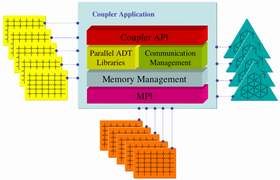|
|||
RANS
LES
Integration
Merrimac
Research ProjectsSimulation Framework | Software Engineering | Physics Modeling | Verification & ValidationIntegrated Multicode Simulation Framework

CHIMPS, Coupler for High-performance Integrated Multi-Physics Simulations CITS overarching problem is the simulation of the complete aero-thermodynamic flow path through a jet engine. CITS simulation environment is based on Python and built around the Center's flagship codes, CDP (Large Eddy Simulation approach) and TFLO (based on Reynolds-averaged Navier-Stokes equations). It also includes a set of general-purpose interpolation and communication libraries (CHIMPS, Coupler for High-performance Integrated Multi-Physics Simulations). Basic concept: a parallel, scalable, distributed module that automatically takes care of mesh / solution interpolations to exchange information between CFD solvers, Structral dynamics codes, etc. The code-interfacing is designed around a distributed "interpolation server". Participating codes "register" the required data and their locations and "provide" their local mesh and solutions to the other components in the integrated environment. Information exchange (volume/overlap, surface/minimum distance and failsafe) happens transparently to the user through straightforward API. The advantages of this approach are:
|


